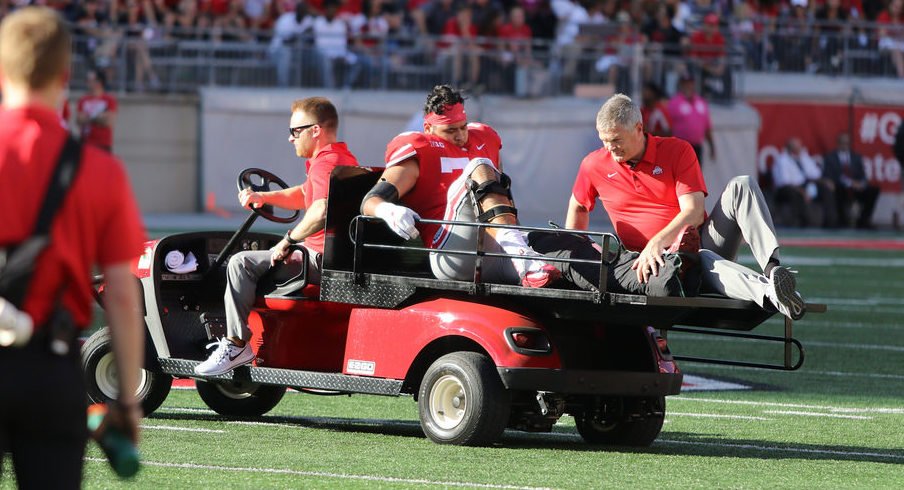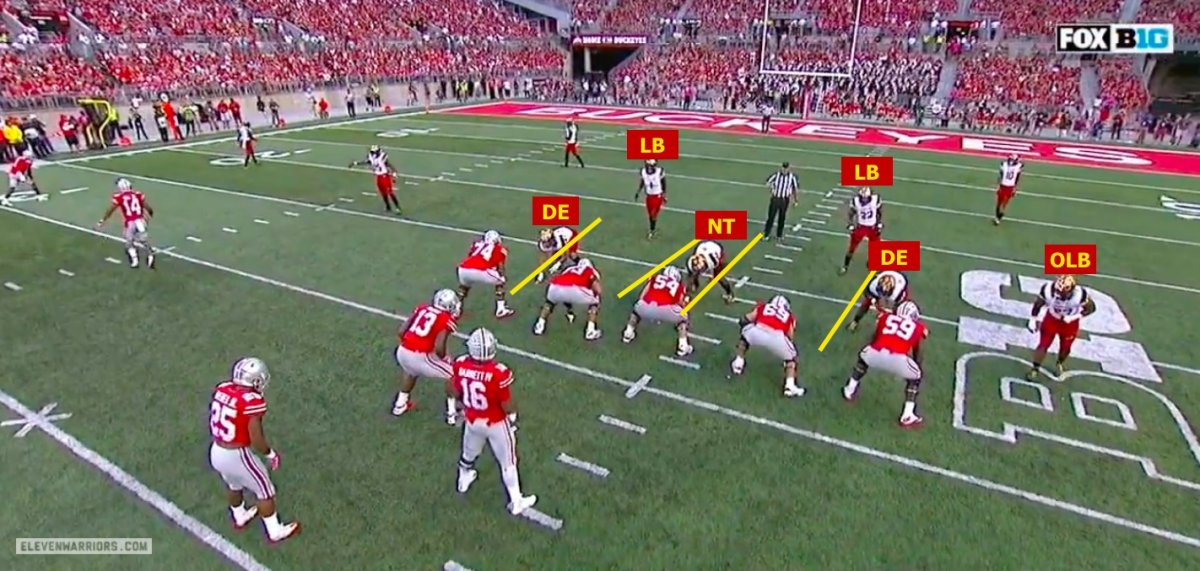FILM STUDY: OHIO STATE'S EFFECTIVE GAME PLAN TO ATTACK THE PERIMETER OF MARYLAND'S 3-4 DEFENSE
Though the offense as a whole failed to move the ball consistently in their lone loss of the season thus far, it's easy to forget that Ohio State still averaged a solid 4.91 yards-per-attempt against the Sooners.
That should come as no surprise to those watching the Urban Meyer era closely in Columbus, as his teams have always made the inside running game the foundation of their game plans. Typically, that has meant a reliance on the 'tight zone' run meant to hit the 'A' gap opposite the back's alignment, with the runner reading the double-team block(s) in front of him.
Given that Meyer has been leading teams for the better part of two decades, opponents have caught on and tried to find ways to slow down the basis of his offense. One of the most successful ways of doing so has been the use of 'odd' defensive fronts that place a nose tackle directly over the Buckeyes' center.
Typically, defenses like to put their linemen in the gaps between blockers, allowing them to more easily fill any potential running lanes. But against teams like the Buckeyes that rely so heavily on the tight zone, odd alignments render the critical double-team blocks neutral, as blockers are forced to choose between doubling a down lineman or getting upfield to take out a linebacker, often leaving their teammates in a vulnerable position.
The Buckeyes have seen a number of variations on this tactic ever since Virginia Tech caught them off-guard with the 'Bear' front four seasons ago. But Maryland typically runs a three-man front, allowing them to easily slide last Saturday into an alignment their opponents typically find so uncomfortable.
Unlike the Bear, which places both defensive ends over the offensive guards, the Terrapin ends lined up just on the inside shoulders of Ohio State's tackles in a 4i look.
For anyone looking for evidence the Buckeye offense has improved under the leadership of Kevin Wilson and Ryan Day, last weekend's systematic demolishing of this odd front (against an in-conference opponent, no less), should offer plenty.
Ohio State had struggled in recent years to find any offensive rhythm against such looks, even when facing far lesser opponents than Maryland. But the Terps proved to be no match this year, as even though much of the focus was (justifiably) on the Buckeyes' 303 passing yards that afternoon, they also racked up 281 yards on the ground at an efficient clip of 5.6 ypc.
With so much focus on the Buckeye passing game, it's been easy to overlook how relatively vanilla their run game had been so far this year, relying almost exclusively on tight zone and showing few of the other wrinkles we've become used to in Meyer's offense (such as Counter-trey, Buck Sweep, and the Jet Sweep). This has been partly due to their opponents' reliance on four-man fronts that leave the natural A-gap 'bubble' for the tight zone to hit.
But this week the game plan for running the football offered a buffet of options to attack the edges of the Maryland defense, as the 4i look of both defensive ends created natural running lanes of their own. The most common way the Buckeyes attacked them was with 'Bash,' the concept that flips the typical tight zone on its head by swapping the roles of the running back and quarterback. With the end aligned inside, the tackle can easily leave him unblocked to be read and get upfield to set the crucial block on a linebacker at the second level.
Entire article:
https://www.elevenwarriors.com/ohio...attack-the-perimeter-of-marylands-3-4-defense








